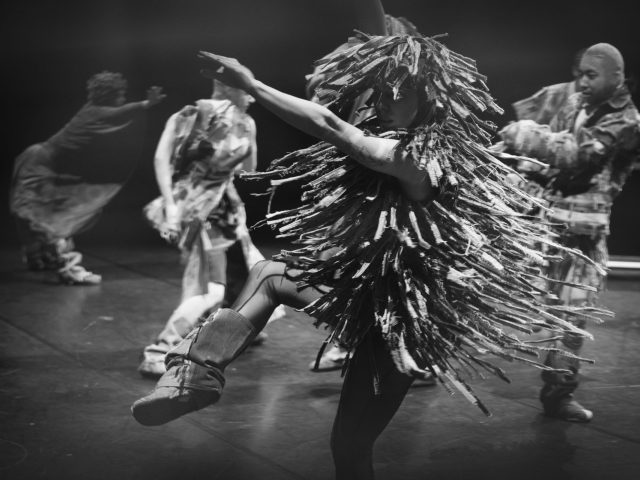- Video
- Ballet
Three choreographers - three movement languages
by Koen Bollen, Wed, May 31, 2023

Both Crystal Pite and Jermaine Maurice Spivey consider William Forsythe as one of their mentors. But Pite and Spivey also influenced each other. The three choreographers may have come from the same artistic family, yet they have clearly developed in different directions. What all three have in common, is that they make the dancers and the audience look at themselves and the world in a different way. All three develop their choreographies in close collaboration with the dancers and they each use different means for this.
A brief overview of their three unique choreographic languages, zooming in on one characteristic element, illustrated by rehearsal footage:
Extant – Jermaine Maurice Spivey
on shearing
Dancers Christina Guieb and Lateef Williams demonstrate shearing, one of the improvisation tasks Jermaine Maurice Spivey uses in his new piece Extant. In doing so, the dancers constantly seek out extreme direction in their bodies, each time trying to shift and push in multiple directions to reach even further. Just as a Rubik's cube rotates around its axis in different directions, so do the dancer’s bodies rotate around their spine, constantly showing new versions of themselves.
Jermaine Maurice Spivey: ‘The performances I’ve made in recent years all deal with the same theme: being. How can you own your identity and evolve at the same time? How can I be in a relationship with someone or be in a community without limiting myself or having to be one version of myself? (...) I'm interested in shearing because it forces the body to be decentralized, it forces you to focus on more than one thing at the same time. That's what I think working on yourself feels like. When I say work, I mean the work we all have to do now to reconsider, reprioritize and reframe. Shearing is a task that the dancers have to perform almost continuously from beginning to end of Extant. You can't really disengage yourself from it, which is also a metaphor for me. It leads me to see the dancers more as people, even though they look physically unusual because of the multiple layers. I think that's what people look like on the inside. That's what makes it so authentic.
If you really do it (shearing), it will authentically be exactly what it needs to be. But if you try to perform a version of it that you think looks best, it won't work. I don't consider myself an activist, but as an artist I question myself. I question the world. I question how people perceive other people and try to turn that into art. What does questioning look like physically? That’s exactly what is demonstrated in Extant's movement language.’ (Interview Jermaine Maurice Spivey, program book OBV june 2023)
One Flat Thing, reproduced – William Forsythe
on counterpoint
In this video, the dancers of OBV are rehearsing William Forsythe’s masterpiece One Flat Thing, reproduced. Very clearly noticeable is the element of counterpoint, crucial for the choreography of this work. Norah Zuniga Shaw, who wrote an extensive article on this work, elaborates.
‘Like any artwork, One Flat Thing, reproduced is open to multiple interpretations but one of its greatest contributions is found in its choreographic counterpoint and the structural elements that create it. The visual counterpoint in Forsythe’s choreography is akin to musical counterpoint and polyphony but also independent of it. The counterpoint you will witness in this dance consists of fragmentation and recombination of movement themes, a highly complex network of cause-and-effect relationships that we call cueing, and most of all, fleeting alignments in shape, space, timing, and trajectories between dancers’ motions. Seeing counterpoint through this dance increases the pleasure of watching, probably because, as cognitive science tells us, humans are pattern-seeking animals and pattern recognition is a transferable skill.
Understanding counterpoint in One Flat Thing, reproduced helps one to view all of William Forsythe’s work anew and indeed to view other contemporary dance and even the world around you in new ways. Rather than seeking unison, which can suppress individual thinking and creativity, in counterpoint, alignments can be created wherever there are forms of agreement and degrees of similarity.’ (Norah Zuniga Shaw, Living in counterpoint, program book OBV june 2023)
Ten Duets on a Theme of Rescue – Crystal Pite
on building her theme of rescue
In this video of an early rehearsal, dancers Claudio Cangialosi and Shane Urton are working on the sixth of the ten duets of this piece. They are focused on momentum, risk and a feeling of high stakes. The goal for the dancers is being available and alert, when someone is suspended at their edge. The dancers build this duet with a strong sense of urgency. In the recent interview Crystal Pite gave on the occasion of the performances in Antwerp and Ghent, she describes the process of creation and the theme of this work.
‘I made Ten Duets in the record time of ten days. Because of that lack of time, I needed an efficient initial structure: I planned to create ten duets with two casts of five dancers. I just quickly started building the duets without thinking too much. I worked on certain qualities and dynamics and with an eye for the characters of the dancers themselves. After about a week, I started looking within those duets for moments or images that evoked the theme of rescue. I then emphasized those moments more and worked them out further. I eventually built the piece around this theme more overtly and that’s how it got the title.’ (Interview with Crystal Pite, program book OBV june 2023)